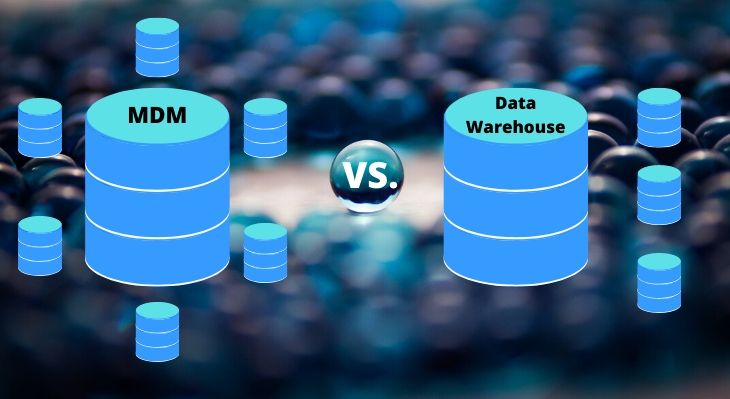In today’s technological era, where data is increasingly emerging as a key factor in running a business, there is a growing need to use or produce high-quality data in new services and products.
Defining roles and responsibilities, as well as monitoring and refining quality assurance are critical to success factors.
The stressful process that companies are going through to make consistent reports and comply with regulations, has sparked a keen interest in master data management (MDM) and data warehousing.
This article explains the difference between MDM and data warehouse on the basis of what they are and how they can help in the business process.
Master Data Management (MDM) is a methodology that identifies the most critical information within an organization and creates a unique source to truly deliver power to business processes.
MDM involves a variety of technology solutions, including data integration, quality, and business process management.
Performed in accordance with the rules of the art, the MDM streamlines the sharing of data at the staff and service levels.
At the same time, MDM facilitates IT processing in environments with multiple system architectures, platforms, and applications.
MDM is a particularly attractive solution for large organizations and those with frequent or large-scale merger and acquisition activities.
The acquisition of another company creates challenges for integrating large-scale data that a central data repository is perfectly capable of meeting.
Thus, this solution can considerably speed up the valuation time of acquisition.
Some key Benefits of MDM include:
- 360 ° customer vision
- Quick implementation and therefore faster return on investment
- Cost optimization
- Consistent data containing all relevant information
- Support for change within the framework of the project
- A Complete View of All Interactions
- Improve risk management and regulatory compliance
Data Warehouse is an intermediary storage location for the various data in order to build the decision-making information system.
It is a warehouse in which a remarkably large volume of consolidated data is organized from the multiple sources and information of an organization.
Data Warehouse architecture may vary depending on the type of subject covered, this is due to needs that vary from company to company.
Single-tier architecture: The generic architecture comprises the operational data layer that will be accessed by the data access layer.
The process management, transport, and data warehouse layers are responsible for distributing data and are at the heart of the architecture.
The information access layer makes it possible to extract data from the data warehouse using a set of tools.
Two-tier Architecture: The two-tier architecture utilizes a server, along with front end applications, which are tools that perform operations on queried data and make them useful information for users, back end components.
These tools are responsible for extracting, cleaning, and loading data.
Three-tier Architecture: The three-tier architecture supports multiple users and services because of its flexibility, information is stored in multiple tiers.
In the first layer are the interfaces that work with the user, where they are usually graphical.
In the second tier, there are database servers and applications, so they need efficient and fast access to shared data, and in the last, the data sources are stored.
The three-tier architecture is the one most used by analysts.
Some key benefits of data warehousing
- Enhances data quality and consistency.
- The data warehouse delivers enhanced business intelligence.
- Timely access to data.
- Data warehouse data is non-volatile containing historical as well as current data.
- Increases productivity of corporate decision-makers.
- Removes the loading of information and processing from transactional databases.
Dell Boomi
This tool enables users to create and deploy integration processes using a visual interface with a drag and drop feature.
Specialized in API management, cloud-based integration, and MDM services, this technology was acquired by Dell in 2010.
Informatica MDM Solution
Informatica is one of the leading players in the industry, it draws information from various sources and builds a complete, reliable, and accurate master record.
You can keep up with the growing need for services, security threats, and demands to increase efficiency and transparency with a single, unified view of all data.
SAP Master Data Governance
With built-in data governance based on pre-configured data models, SAP Master Data Governance is the master data management solution from enterprise application software provider SAP.
This solution provides a role-based user interface, automated routing, and audit trail for changes to master data with Collaborative and pre-built workflows.
Tableau
Data can be the big competitive differentiator for your company. In this sense, Tableau is a more powerful and widely used software.
In addition to data warehousing solutions, it benefits aspects of IT infrastructure and key technical points for your application.
Xplenty
Xplenty is a data delivery cloud platform that enables the integration and processing of data from a variety of data stores and SaaS applications.
The prominent feature of this tool is that it centralizes and prepares data for BI, as well as transfers data between internal databases or data warehouses.
Panoply
Panoply comes with an automated data warehouse with built-in ETL data ingestion that collects, combines, and optimizes all your data. It has over 100 pre-built automated data source integrations.
Data warehouse sources are usually operational. In these types of systems, the master data only appears when an activity takes place.
Master data management often consolidates all possible master data sources, with not only data relevant to or produced by internal systems, but also with reference to external data.
You may also like to read:
Data Warehouse vs. Data Mart: What’s the Difference?
Evolution of Master Data Management (MDM) in the modern analytics era

